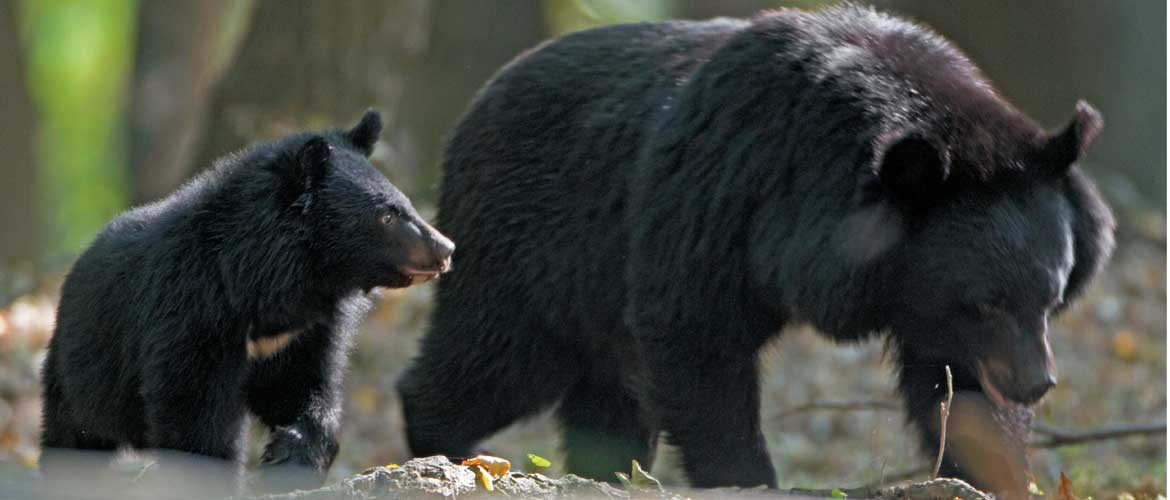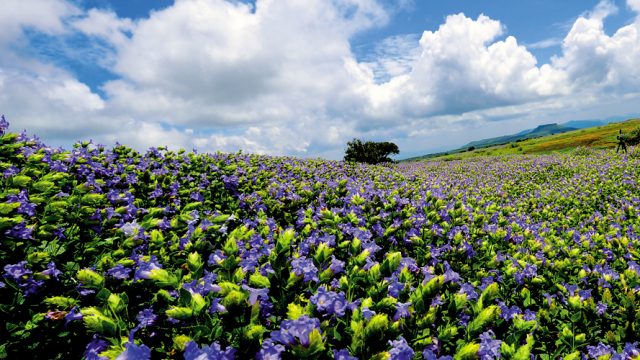Once the hunting grounds of the maharajas of the princely state of Jammu & Kashmir,
The beautiful Dachigam National Park begins from the east bank of the Dal Lake in Srinagar, gently going uphill and gradually widening on a plateau thereafter. Alpine trees line the ascent (this part is called Lower Dachigam) and soon a dense forest engulfs you mid way. After a 10-km-trek uphill, the middle Dachigam welcomes you with a thicker and more diverse range of flora. It is interesting to note that the terrain starts changing considerably from this point. The hilltop and the plains beyond, called Upper Dachigam, is a different land altogether. It has much harsher winters and one requires a special permit to trek all the way up.
The variety of wild trees here include cherry, pear, plum, peach, apple, apricot, walnut, chestnut, oak, willow, poplar, chinar, birch, pine and elm. The park is spread across 141sq km and lies in an altitudinal zone of 1,700–4,300m. There is only one entrance/exit to the park.
■ Entry ₹25, upon approval of the wildlife office where you get the permit Timings 10.00am–5.00pm
About Dachigam National park
The forest area belonged to Maharaja Hari Singh, and was declared a protected area in 1910. After 1947, the central government took over the management of the park. In 1951, it was declared a wildlife sanctuary and a national park in 1981. The park’s name was derived from the dachi gam (ten villages) that were relocated from here.
In 1993, a major encounter took place here between Indian security forces and militants. The gunbattle led to a massive fire in the park. Although forest guards managed to douse the flames, the fire had caused a lot of damage by then.
While a tremendous amount of work has gone into conserving the natural habitat of the birds and animals, a sheep-breeding farm that was opened by the state government a few years ago, has had a detrimental effect. Taking a cue from the farm activities, locals bring their goats and cattle for grazing here, causing the grasslands to shrink.
The Dachigam forest functions as a catchment area for Srinagar, feeding the Harwan reservoir that supplies fresh water to the city.
THINGS TO SEE AND DO
Located on the outskirts of Srinagar, Dachigam is easy to access. There are a plenty of cheap transport options available. Whether you are a trekker, a wildlife enthusiast or a photographer, Dachigam National Park has more than enough attractions to keep you occupied.
Bunkers
The reality of Kashmiri insurgency stares you in the face, as every now and then, you will come across a CRPF or BSF checkpost blocking the road. Machine-gun-toting soldiers can be seen in the bunkers, keeping an ever vigilant eye out for trouble. The only practical way to see the majority of the park is by exploring the forest on foot. As one walks the trails, signboards direct you on the route and warn visitors against the presence of wild animals.
Wildlife
From the endangered hangul, the Himalayan black bear, species of wild goat such as markhor and ibex, to leopards and Himalayan birds, Dachigam National Park is a delight for wildlife enthusiasts.
The hangul or Kashmir stag belongs to the red deer family of Europe, and is found only in Dachigam in India, outside of Europe. It is characterised by its white rump patch and impressive spread of antlers, and is quite easy to spot in this wilderness. The best time to catch a sight of the hangul is early in the morning. During winter, a herd of hangul can be spotted traversing from snowy Upper Dachigam to the lower valleys. To catch a sight of the Himalayan black bear, one needs to go deeper into the glades surrounded by oak trees. Bears flock to these open spaces to eat acorns, which fall off the oaks.

Leopards
Those who are unable to spot any animals in the park, shouldn’t feel disheartened. While leopards are not easy to spot amongst the foliage, there is a separate enclosure for these big cats in Lower Dachigam.
Birds
Birdwatchers can look out for the crimson tragopan, blood pheasant, koklass pheasant and the iridescent monal, which has a glittering plumage. If you are lucky, the golden eagle and the bearded vulture can also be seen circling the blue skies. Do not forget to carry binoculars.
Trout farm
Besides animals, the park also houses a reservoir for trouts. It is situated a few metres inside the entrance gate. Visitors require special permission from the wildlife warden’s office to visit this large natural water body.
Trekking
Lower Dachigam has a very gentle terrain and trekking here is easy even for those who aren’t very fit. Upper Dachigam has a more difficult trekking route.
FAST FACTS
When to go Open from May 1–December 31, closed from January–April
Best sightings Upper Dachigam: May–August; Lower Dachigam: September–December
Wildlife/ Forest Dept offices
Wildlife Warden, J & K
Near Dal Lake, Below Grand Palace Hotel. Srinagar-190001
Tel: 0194-2501069
Foreigners’ Regional Registration Office (FRRO)
SSP (CID)
Special Branch,
Shervani Road, Srinagar
STD code 0194
AROUND DACHIGAM NATIONAL PARK
Srinagar (22km)
There are plenty of sightseeing options in Srinagar, starting from Dal Lake, to the Mughal gardens such as Shalimar Bagh and Nishat Bagh. Chashme Shahi is another beautiful botanical garden in the city where one can go for a picnic or simply to enjoy an afternoon siesta.

Besides being world famous for its scenic beauty and gorgeous shikaras (boats), the Dal Lake is also known for the floating vegetable market. Head to the lake at dawn to witness this. The only one of its kind in India, and second in the world – the other being the rowing shops along the backwaters of the Mekong Delta in Vietnam – the market is a must-visit. Another destination in Srinagar is the Garden of Char Chinar. Nagin Lake and the canals of the old Pandit quarters of Rainawari are other pretty sites.
The Shankaracharya Hill is an interesting place, south of the Dal Lake. The hilltop has a temple associated with Adi Shankaracharya, who is said to have meditated here.
Sher Garhi Palace and Gulab Bhawan also draw many tourists around the year. The best way to get around the city is to hire a Sumo at the taxi stands at the Tourist Reception Centre and Tang Bagh.
WHERE TO STAY AND EAT
Dachigam itself has very few stay options and the Wildlife Warden’s Office (Tel: 01982-2501069) rarely issues permits necessary to stay in facilities located inside the park. Accommodation, however, is seldom an issue as Srinagar is very close by. There is no eatery inside the park, so carry your own food.
In Srinagar
Undeniably the most charming of Srinagar’s accommodation options are the houseboats. These floating beauties have very pretty and comfortable ‘deluxe rooms’, attractively carved wooden furniture, attached toilets, running hot water, simple breakfast and dinner, and a common balcony and TV lounge.
They are moored to the lakeside away from the boulevard, and you can access the boulevard using the free shikara rides that they provide.
The rates, fixed by the Srinagar’s Houseboat Owners’ Association, range between ₹800–4,800 (room only) and ₹1,690–7,400 (with meals).
Some of the top-end houseboats here are WelcomHeritage Gurkha Houseboats (Tel: 0194-2421001, 2425229, Tariff: ₹9,000), that float peacefully on the Nigeen lake, and the Butts Clermont Houseboats (Tel: 2415325/ 220, Cell: 09419056761, Tariff: ₹7,400) tucked away from the crowds, in Naseem Bagh at the Hazratbal end of Dal lake.
For a good mid-level houseboat, you can try the pleasant Badyari Palace (Cell: 09018084043, Tariff: ₹3,800–4,800) situated on the Dal lake. It is easily accessible from the boulevard’s Ghat 9.
Hotels
The most alluring and expensive of Srinagar’s hotels are the Lalit Grand Palace (Tel: 2501001/ 02, Tariff: ₹16,000–1,75,000) and Vivanta Dal View Srinagar by Taj (Tel: 2461111, Tariff: ₹17,000–1,15,000). The Broadway Hotel (Tel: 2459001, Tariff: ₹13,100–15,900) is a comfortable option located close to the Dal Lake. A cheaper alternative is Hotel Bombay Gujarat (Tel: 2477807, Cell: 09796151236; Tariff: ₹800) at Lal Chowk.
One can also opt for the charming Mahatta Homestay (Tel: 2313456, Cell: 09419079747, 09796079747, Tariff: ₹3,500–4,500), the oldest homestay in Rajbagh. Almond Villa (Cell: 09971924583; Tariff: ₹5,000–7,000) is another good homestay on Boulevard Road.
WHERE TO EAT IN SRINAGAR
Ahdos and Mughal Durbar on Residency Road, Ruby in Lambert Lane and Juniper in Lal Chowk are well known for Kashmiri food. The Dal Gate-Kohna Khan area and the lake-facing boulevard have many north Indian restaurants. Hotel Broadway’s Coffea Arabica is like a snazzy laidback foodcourt offering Italian and Lebanese cuisines, milk-shakes, coffee and much more.
GETTING THERE
Air Nearest airport: Srinagar (22km/ 30mins). Air India and Jet Airways offer daily flights in season. Taxi fare ₹1,000
Rail Nearest railhead: Jammu (315km/ 9hrs). Shared Sumo taxis cost ₹500–850 per head to Srinagar
Road You can drive from either Srinagar or Jammu. A road links Srinagar to Lower Dachigam. Upper Dachigam can be reached on foot. Taxi return fare (full day) ₹1,500–2,000
State Jammu & Kashmir
Location On the periphery of state capital Srinagar, sloping down towards the Dal Lake
Distance 22km E of Srinagar
Route from Srinagar State road to Dachigam National Park via Shalimar Bagh and Harwan
Jammu & Kashmir
North Zone
OT Getaway Guides




